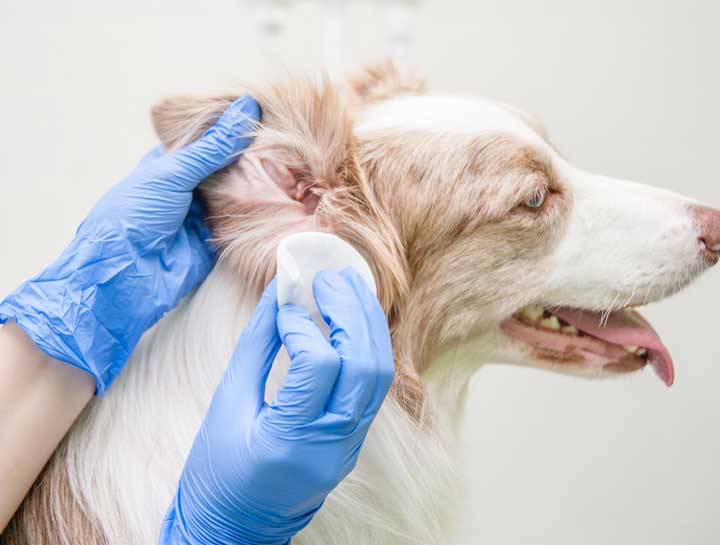Ear Health Management
Diagnosing and treating common issues.
Common Challenges Regarding Dog Ear Health
Ear problems are not uncommon in the pet community. These conditions can result in a variety of painful symptoms, and some of them can grow increasingly serious without prompt treatment. Here at Adobe Pet Hospital, we not only treat these ear problems — we also offer preventative checkups and home care recommendations to prevent them from happening in the first place.
Many animals’ ears offer a relatively large passageway from the outside world into the ear canal, and ultimately to the delicate structures of the middle and inner ear. This complex architecture provides not only for hearing but also for normal balance. Older dogs who appear dizzy or tend to lean in one direction, for example, may be suffering from an inner ear disorder called labyrinthitis. A more common everyday threat, however, is infection.
A dog ear infection may be caused by a wide range of irritants, pests, and/or germs that enter the ear canal. Ear mites are a typical example. These tiny creatures are almost invisible but can cause a great deal of trouble and discomfort for your pet. They use natural oils and ear wax as a food source and seem to have a special affinity for outdoor cats, though they can be spread from cats to dogs.
Ear mites cause your pet to scratch or paw at the itchy ear continuously, and this abuse can cause the smaller blood vessels under the skin to burst, forming a painful, swollen hematoma of the ear flap. The constant scratching may also break the skin, allowing bacteria to enter and creating a secondary dog ear infection. Bacteria, allergens, or other foreign matter can also enter the ear directly, creating redness, swelling, itching, and pain. Serious ear infections may even lead to temporary or permanent hearing loss.
Allergies are another important factor. While in humans, allergies often lead to runny eyes or nose, in pets we often see “runny skin” or a local rash or an ear infection. Many food or environmental allergies result in excessive ear wax production. Yeast and Bacteria that normally live in the ear use this as a food source, causing an ear infection.
Treatment for Ear Mites, Bacterial Infections, and Other Conditions
Fortunately, many forms of cat or dog ear infections can be prevented through a combination of regular home hygiene practices and periodic wellness evaluations at our veterinary clinic. By inspecting pets’ ears and washing them gently with a veterinary-approved cleaner, owners can clear the outer visible part of the ear and ear flap of ear mites, fox tails, or dirt that might foster bacteria. We can advise owners on proper home care techniques to promote cat or dog ear health.
Owners should also learn to recognize the signs of a possible deeper ear canal issue, such as shaking of the head, scratching at the ears, and health symptoms such as a foul odor, local inflammation, or fluid discharge. If your pet does show signs of an ear problem, our doctors can perform a thorough examination of the ear, discover the underlying cause, and prescribe the proper medications or other treatments to resolve the issue and relieve your pet’s discomfort. We can then discuss a wellness routine to help maintain good ear health for life.
Underlying Causes of Chronic Pet Ear Disease
Sometimes certain medical conditions make your pet more susceptible to ear infections and may be responsible for repeated infections. Identifying, or ruling out, these underlying problems is extremely important in treating dogs with recurrent or chronic ear disease. Failing to treat the underlying cause is the root of many treatment failures we see.
- Allergies – both inhalant allergies (atopy) and food allergies
- Hypothyroidism, Cushing’s Disease, and other endocrine disorders
- Foreign material trapped deep in the ear canal or middle ear
- Growths, polyps, and tumors in the ear canal
- Resistant bacterial or yeast infections (often caused by the overuse of ineffective medications)
- Feline Leukemia (FeLV) and Feline Aids (FIV) infections in cats
- Autoimmune diseases including Lupus
- Ear mites (usually seen in young kittens)
Pet Ear Care Resources | Video-otoscopy
We are equipped with Video-Otoscope which helps with performing deep ear flushes and/or middle ear canal flush if warranted. However, not all pets with chronic ear infections are good candidates for such a procedure. We evaluate and advise on a case-by-case basis.
Frequent ear issue season is upon us, please contact our office at (925) 449-4228 for more information.

